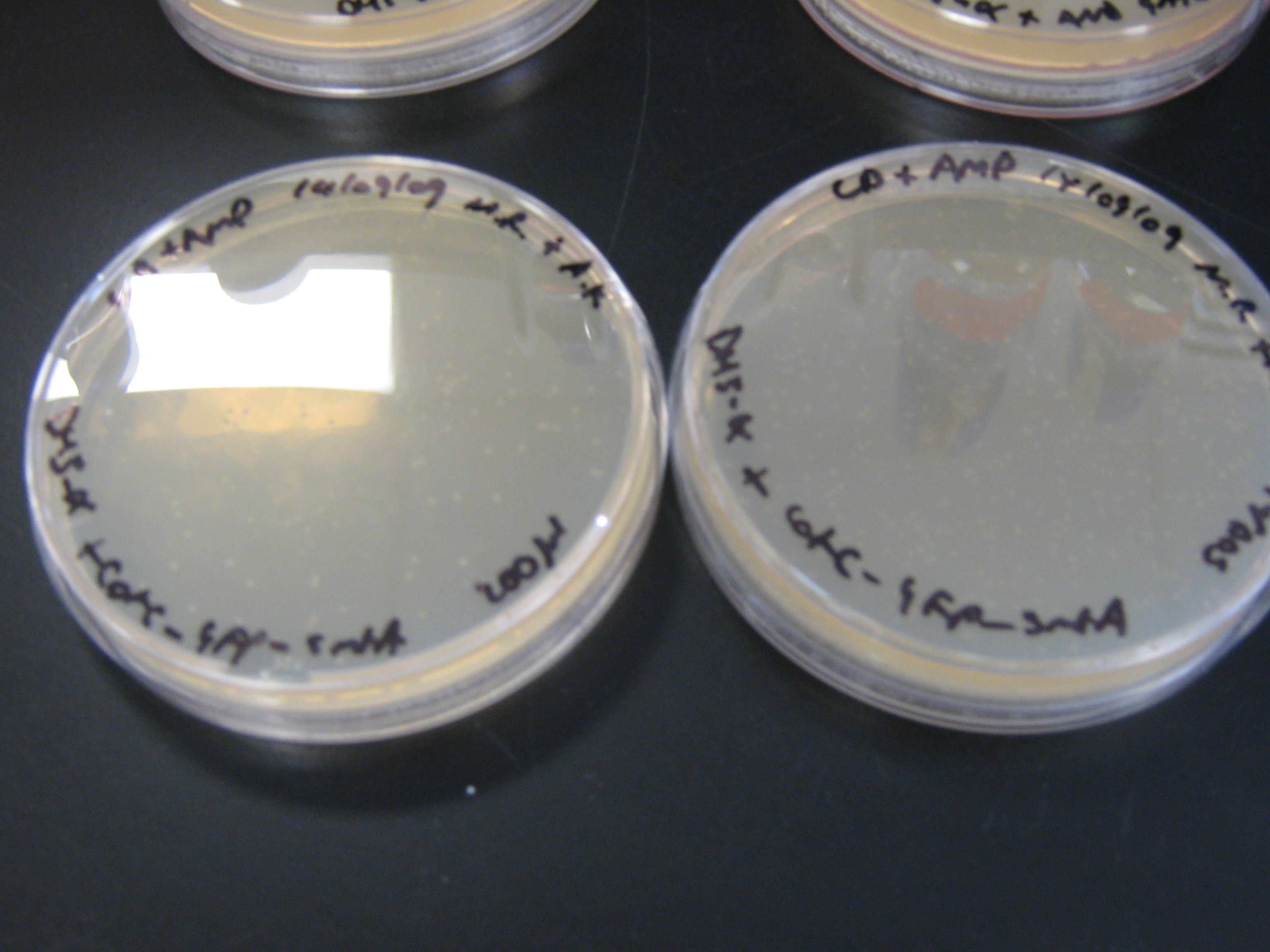Team:Newcastle/Labwork/15 September 2009
From 2009.igem.org
(→Digesting midi-prep samples) |
(→Digesting midi-prep samples) |
||
| Line 95: | Line 95: | ||
<br> | <br> | ||
The digest reactions were allowed to run for 1 hour at 37ºC (waterbath). | The digest reactions were allowed to run for 1 hour at 37ºC (waterbath). | ||
| + | <br> | ||
| + | 9ul of each of the samples were taken and placed into 5 Eppendorf tubes. 1ul of loading buffer was added to all samples and mixed. The DNA samples were then loaded into agarose gel and placed under DNA gel electrophoresis for about 1 hour. However the electrophoresis failed because the gel was too thin. Another attempt will be made at a later date. | ||
<br> | <br> | ||
Revision as of 13:49, 8 October 2009
Formal Lab Session - 15th September 2009
Stochastic Switch Team
Today we set up another restriction disest of the KinA pMKRQ synthesised brick using NheI and EcoRI we ran this on an 0.8% gel however we think that this may be too dilute and that I why we are not seeing the two bands ogf the digest which are a similar size.
We also set up another PCR of the ara fragment as a back up plan for ligation, in case the last ligation did not work as well as we had planned.
We also mini prepped and digested the sac transformations again, and we found that of the 6 samples we had, a few of them had worked!
Just to confirm however we set up 12 more miniprep cultures again for both sac and ara.
Yesterday we did midipreps of Goksels successful sspb plasmid: this was cut with XbaI and PstI ready for ligation into the ara brick (once it's ligated!).
Metal Sensing Team
Introduction
Yesterday's lab session saw the Metal Sensing team ligate the cadA promoter region with the linearised BBa_J33206 BioBrick (BioBrick containing arsR gene and binding site but with promoter absent). The team also attempted to ligate cotC and linearised pMUTIN4. Both of these ligated products were used to transform DH5-alpha E. coli cells.
Today's work will involve the team looking for transformant colonies on the plates and processing them based on observations. If there are colonies, 12 will be picked and used to inoculate 12 tubes of 5ml LB (+ antibiotic) for mini-preps. If unsuccessful, another attempt at ligation and then transformation will follow. The team will also carry out digests of the 5 midi-preps we had done earlier to prove that they have the correct DNA.
Practical Outline
Here are the tasks the Metal Sensing team need to get done by the end of the day:
- Check plates for cotC-GFP-smtA transformants and arsR-cadA AND gate transformants
- If successful prepare for mini-preps by picking 12 colonies and using them to inoculate 12 tubes of 5ml LB
- If unsuccessful, reattempt ligations and transformations in E. coli cells.
- Digest the 5 midi-prep samples (cotC-GFP-smtA, kinA, pGFP-rrnB, pMUTIN4 and pSB1AT3) to ensure the DNA is correct.
- Run these digests on gel to analyse.
Observations
It can be seen from the photograph above that there are colonies present on the cotC-GFP-smtA transformant LB + amp plates suggesting that the ligations and transformations were a success. This cannot be said for the cadmium sensor 'transformant' cells which did not yield any colonies on the LB + amp plates.
Procedure
Preparation for cotC transformant mini-preps
To prepare the cotC BioBricks for midi-preps, 12 colonies were picked from the LB + amp plate containing 200ul of transformant cells. These colonies, under aspetic conditions, were then used to inoculate 12 tubes of LB + ampicillin. The tubes were transferred to the orbital incubator for overnight growth at 37ºC.
Digesting midi-prep samples
The digests on the cotC, kinA, pGFP-rrnB, pMUTIN4, and pSB1AT3 midi-prep DNA samples were carried out as follows:
| cotC | kinA | pGFP-rrnB | pMUTIN4 | pSB1AT3 | ||
|---|---|---|---|---|---|---|
| DNA (ul) | 10 | 10 | 10 | 10 | 10 | |
| Buffer (ul) | 2 | 2 | 2 | 2 | 2 | |
| EcoRI (ul) | 1 | 1 | 1 | 0 | 1 | |
| PstI (ul) | 1 | 1 | 0 | 0 | 1 | |
| BamHI (ul) | 0 | 0 | 0 | 1 | 0 | |
| Water | 6 | 6 | 7 | 7 | 6 |
The digest reactions were allowed to run for 1 hour at 37ºC (waterbath).
9ul of each of the samples were taken and placed into 5 Eppendorf tubes. 1ul of loading buffer was added to all samples and mixed. The DNA samples were then loaded into agarose gel and placed under DNA gel electrophoresis for about 1 hour. However the electrophoresis failed because the gel was too thin. Another attempt will be made at a later date.
Ligation of cadA promoter and arsR BioBrick
Transformation of E. coli with ligated product
News
Events
- 20 – 21 June 2009 - Europe workshop (London)
- 23 – 24 June 2009 - UK iGEM meetup (Edinburgh)
- 23 October Practice Presentation (Newcastle)
- 23 October T-shirts are ready
- 27 October Practice Presentation (Sunderland)
- 27 October Poster is ready
- 30 October – 2 November 2009 - Jamboree (Boston)
Social Net
- Newcastle iGEM Twitter
- [http://www.facebook.com/home.php#/group.php?gid=131709337641 Newcastle on Facebook]
- [http://www.youtube.com/user/newcastle2009igem Newcastle Youtube Channel]
 "
"

